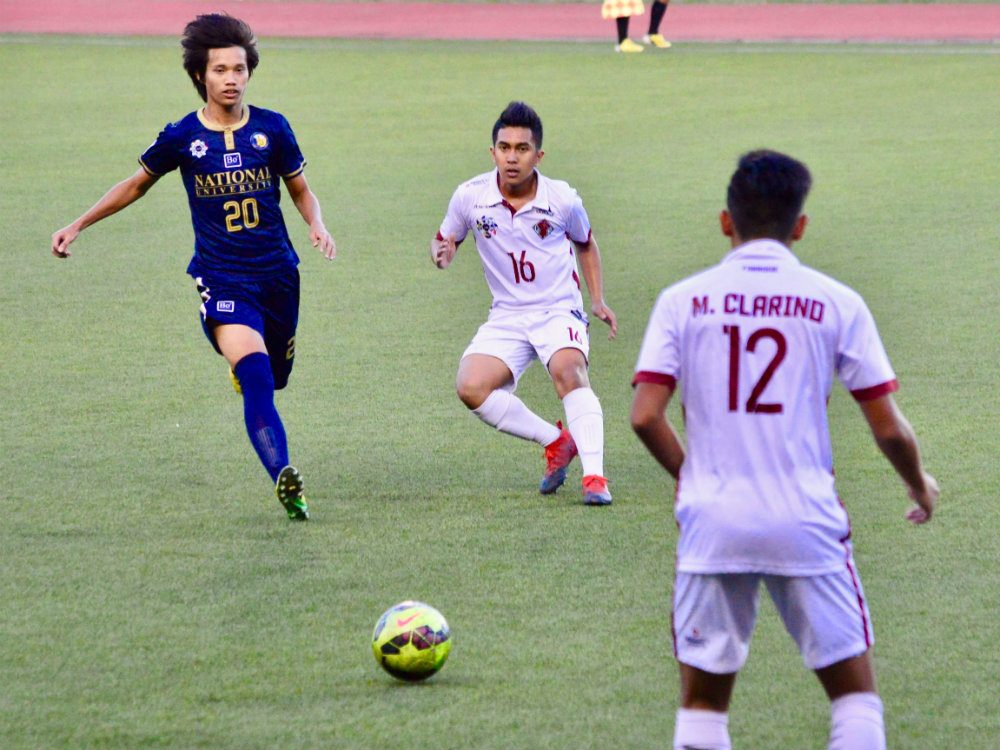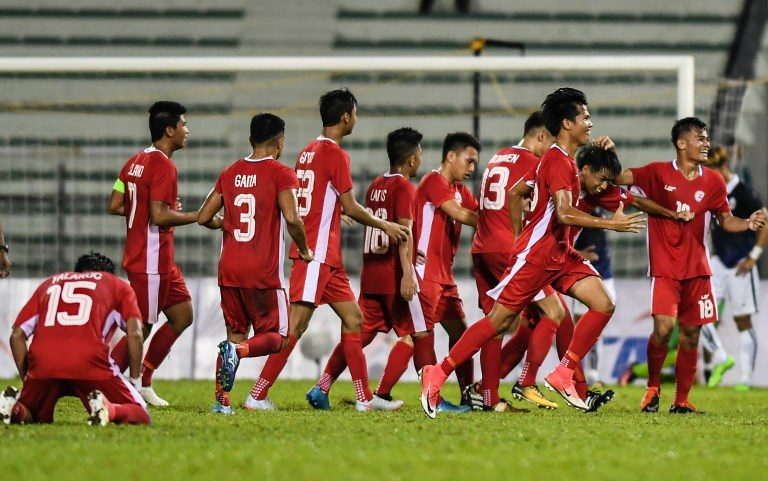SUMMARY
This is AI generated summarization, which may have errors. For context, always refer to the full article.

The U22 Azkals beat Timor Leste 2-1 on Thursday, August 24 thanks to two goals from Jarvey Gayoso. The Pinoys finished fourth in their 6-team group and out of the running for a medal, but there are many talking points about this finish.
This achievement is historic. After the news of the win came through I took a headlong dive into Wikipedia to see how this 2-0-3 finish stacked up against SEA games teams of yore. Mind you, Wikipedia is not the most reliable of sources and I wish I had something more official to look at online, but I would think it is generally accurate.
It turns out that Philippines had never previously won two matches in a SEA Games in men’s football since the competition began calling itself the SEA Games in 1977. That year we beat Brunei 4-1 and eked out a 1-1 draw against Indonesia. Fourteen years later, playing at home, the Philippines matched that achievement, famously defeating defending champs Malaysia 1-0 and drawing Vietnam 2-2. I watched both of those matches myself in Rizal Memorial. We reached the semis but were routed by Thailand 6-2 then fell to Singapore 2-0 in the bronze medal game.
When we next hosted in 2005 the Philippines beat Cambodia 4-2 but fell to Malaysia by the same score in the last group game in Panaad.
This year, two victories. That means in theory this is the best SEA Games team ever in terms of points, but is second to the mythical 1991 squad in terms of progression in the competition.
Nevertheless it is an improvement over 2015, when the side went 0-4 in the SEA Games. The opening day win against Cambodia was our first in the SEA Games since 2011, when we only beat Laos in what was an otherwise sorry campaign that even saw us lose to Brunei.
True, the wins come against the lesser lights of the region, but an accomplishment like this still deserves acclaim. Based on this result we are definitely in the region’s middle class now, alongside the likes of Laos and Singapore.
The standard of homegrown players is incrementally improving. Only 6 overseas-bred players went to Malaysia, namely Fil-Aussies Josh Grommen and Enzo Cheng, (who might have been injured because I don’t believe he played), Fil-Belgian Dylan DeBruycker, Filipino-Japanese Kouichi Belgira and Yoshiharu Koizumi, and Hong Kong-bred Fil-Brit Jordan Jarvis.
DeBruycker is a superb player whose appearance in the senior squad is only a matter of time. But for me the best of this lot was Grommen, who covered lots of ground and came up large with many key plays. Grommen plays for Ceres and one can imagine that training every day against the House of Horrors that is the Ceres attack only sharpened him for this competition.
Grommen was suspended for the final game against Timor Leste but the Philippines won anyway, with Jayra Rocha and Junell Bautista picking up the slack in the back line.
This squad was overwhelmingly homegrown, and that makes the two wins that much sweeter. Over the years there have been plenty of small improvements here and there that have nudged the level of Pinoy youth football upwards. The UAAP has expanded to a full eight teams, the NCAA has also added new sides, and the UFL had a good youth competition that is now known as the Youth Football League or YFL. Entities like RIFA have carried on as well as other competitions.
A lot of these players also have UFL and PFL experience so they know what it’s like to play against and with professionals.
The PFF has also continued with coaching license courses all over the nation. Having even a C license coach run training for kids in a provincial setting is massive. The number of licensed coaches has ballooned over the last few years, and the count of A license coaches will almost double once the ongoing batch is done.
No doubt all of this has helped. But what is also remarkable is the spread of talent from all over the country.
Fifteen years ago it would have been impossible to think that we could win 2 matches in the SEA Games using a majority homegrown squad without a single player from Iloilo nor Negros Occidental, the country’s traditional football hotbeds. But that is exactly what happened in Malaysia.
The bulk of the team hails from two places: Metro Manila, where competitions, coaching, and proper fields abound, and, amazingly Mindanao. Yoyong Talaroc, Nimrod Balabat, Troy Limbo, Reymart Cubon, and JB Borlongan are all from there and contributed well. Borlongon showed composure and flair in keeping possession, Cubon headed in the opener against Cambodia, and Talaroc, playing his second SEA Games, nearly scored from 40 yards out against Vietnam.
Christian Lapas, from Negros Oriental, was deployed as a centerback in Marlon Maro’s 3-5-2 system and he impressed with his ball skills.

It’s also noteworthy that our goalkeeper, RJ Joyel, comes from Pampanga, and Bautista the defender is a product of Benguet. Football is everywhere in the Philippines. The raw material is there, it only needs to be harnessed fully.
Joyel made one naive concession against Vietnam, letting in a goal off his near post, but otherwise he was “phenomenal,” according to Jarvey Gayoso, in making big saves in both wins.
True, we are still off the pace set by Thailand, Indonesia and Vietnam, who beat us by a combined score of 9-0. (If you did see that 2-0 loss to Thailand you would have noticed that had Gayoso not hit the post in the first half it would have been a different story.) Against Thailand and Indonesia we lacked the midfield quality to keep possession.
Jarvey Gayoso’s star continues to rise. What a year it’s been for the lefty. First he leads Ateneo to a UAAP title then he scores twice and assists in another as we win twice in Malaysia.
Cubon’s goal against Cambodia, a glancing header, is not possible without the piercing, boring corner that Gayoso delivers. It’s a rare skill in the Philippines. Watch it here.
Sadly there appears to be no YouTube link of the Timor Leste win.
“I’m proud to be a part of this team,” said Gayoso after Thursday’s win.
“We broke records and reached new heights in this campaign. We did not reach our goal of making the semis but the experience and hard work paid off nonetheless. It was a great experience getting to know the many talents our country has and I’m positive that we can do better in the next SEA Games.”
Gayoso could be the second coming of Chieffy Caligdong. A lethal left-footed striker with football IQ and speed to burn. Only Gayoso is taller, at around 6-foot or 6-foot-1. But the best part is that his SEA Games career is not yet over because….
The 2019 SEA Games team could be even better. The Philippines will host the next edition of this competition after all. And the men’s football side is brimming with potential.
Gayoso and DeBruycker will still be eligible as long as the tournament remains U22 and doesn’t go any younger. (The SEA Games was U23 before this year.) Ditto for Borlongan, Lapas, Jarvis, and Arellano attacker Papuh Corsame who was useful in this campaign. FEU’s speedy striker Rico Andes should be in the mix, as will be UE’s U19 NT player Mar Diano, who played CB for the national team but is a striker with the Red Warriors.
FEU’s juniors team has Gio Pabualan from Bukidnon, an intoxicatingly gifted attacking mid who can score from distance. I also like NU’s creative midfielder Lawrence Colina and U19 vet Patrick Valenzuela. No one is giving up on DLSU forward Mathew Custodio either, despite an indifferent first year in the UAAP. Soon a highly-regarded Masbateño, Jovan Marfiga, could join him with the Archers.
Kyle Magdato, a rangy UP wide player with finishing skills, is also a contender. Defender Marco Casambre, who got his first senior call-up last year, may even be eligible for both the 2019 and 2021 SEA Games. Then there’s also Ateneo’s Cebuano attacking threat, Enzo Ceniza.
Another name to throw in: Barcelona academy player Sandro Reyes, who played for the U16s recently.
The team will be playing at home. Hopefully in front of a large and throaty crowd. Might a medal be within reach? Could the spirit of the pioneering 1991 squad be invoked?
At any rate, the football community should welcome this baby step towards the top teams in ASEAN. Their patron, Davao Aguilas owner Jeff Cheng, sees this advancement as a boon in more ways than one.
“I see renewed hope and proof that our young footballers are capable of winning games in international competitions. This may get more Filipinos to support and believe in our youth teams. Also to encourage more kids to play the sport, which will give us a wider pool of players. These will be your future football fans for the benefit of Philippine Football, our National Teams both men and women, and the Philippine Football League.” – Rappler.com
Editor’s note: The story has been corrected to state that Junell Bautista comes from Benguet, not Baguio.
Follow Bob on Twitter @PassionateFanPH.
Add a comment
How does this make you feel?
There are no comments yet. Add your comment to start the conversation.